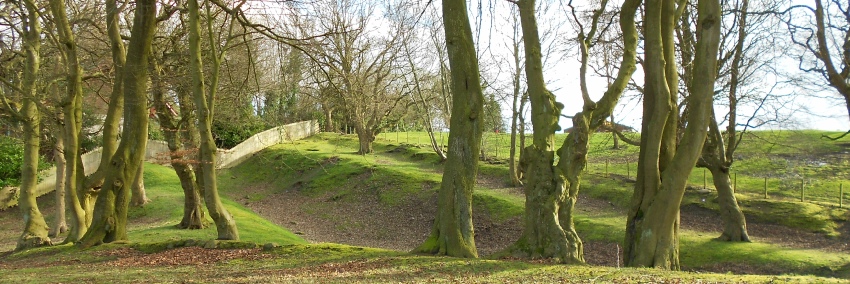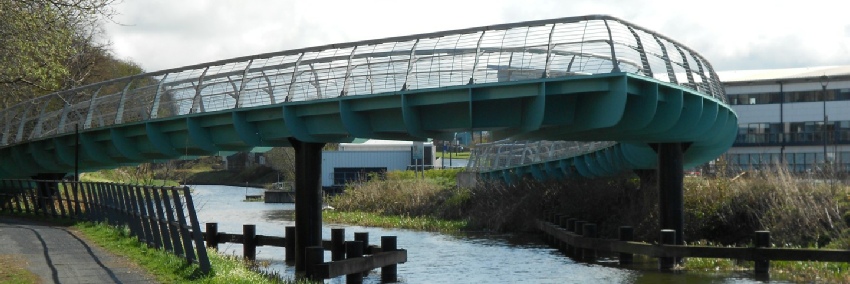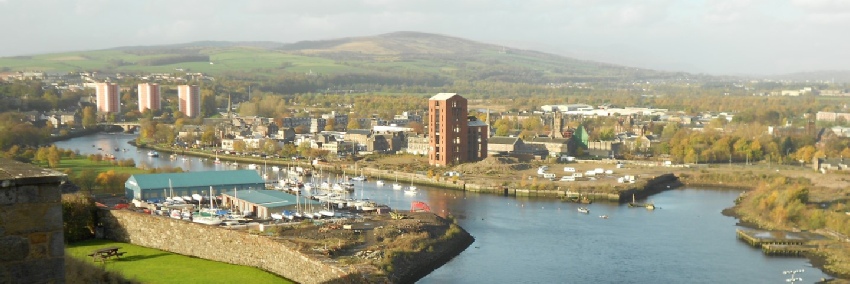Ways and Trails © Cameron Black 2015















































AN ANTONINE TRAIL
Enjoy our Coast to Coast Trail, from River Clyde to River Forth. Explore Rome’s most advanced frontier design and Scotland’s newest World Heritage Site. Visit the amazing Falkirk Wheel. Check out Bo’ness Steam Railway. We tell you about:
Roman history -
Choose your own daily walking distances. Also: choose the 125 km Full Trail or choose the 91 km Short Trail. Both go Coast to Coast.
David J Breeze has written a Foreword.
Others say:
● “Cameron Black must have done an awful lot of research”
● “A really, really, good read”
● “Cameron writes in his usual charmingly idiosyncratic style”
THE ROUTE
Overview
“The Antonine Wall . . . built in turf and timber rather than stone, has suffered rather more from the ravages of time than Hadrian’s Wall. . . . [but] there is more of the Wall to see than is generally realised.”
After an introductory visit to Dumbarton Castle (not Roman) we meet the Wall near Bowling on the Clyde and generally follow it as closely as is practicable – avoiding cultivated fields, housing estates, busy roads, and motorways to the end of the Wall at Bo’ness. We can recommend the extra day to Cramond Village: site of a Roman supply depot fort.
Mindful that you are on holiday, we have taken trouble over our suggested overnight stopping places and convenient refreshment stops. And, since Variety is the Spice of Life, we have included woodland walks, river paths, canal-
Details
● Introductory Day + Wall Day One
● Wall Days Two + Three
● Wall Days Four + Five
● Wall Day Six + Extra Day
Introductory Day + Wall Day One (5+20 km)
Dumbarton Castle offers great introductory viewpoints. You may decide to combine this 5 km stroll with Day 1 which passes four Roman fort sites and shows us how the Romans kept a good look-
Wall Days Two and Three (16 + 16 km)
Day 2 passes three fort sites. We cross the River Kelvin near where the Romans had built their own bridge and we utilise the Forth and Clyde Canal – passing Mavis Valley’s Cadder Coalfield mining disaster. We also learn how one man’s banishment by transportation to Australia started Church of Scotland congregations’ choosing their own ministers. Day 3, from Kirkintilloch, includes ‘the Best Wall Walk’ with dramatic stretches of Antonine Ditch. One of today’s forts, Bar Hill, may have been Medionemeton to the Romans but named by Iron Age Druids. We can pay a lunch-
Wall Days Four and Five (14.5 + 12 km)
Two fort sites, two stretches of Military Way and good lengths of Ditch are on the agenda for Day 4. Today’s star turns are the Falkirk Wheel, with a boat trip possible, and Rough Castle Roman Fort with ‘Lilia’ – pits for trapping intruders. Some of you may combine Day 4 with shortish Day 5 which includes a walk through the Union Canal Tunnel and a visit to Falkirk Council’s spectacular Callendar House.
Wall Day Six and the Extra Day (16 + 25 km)
Day 6 dodges the M 9 but gives us great views across the Forth Estuary. We must decide whether to end our holiday today, at the Bridgeness laser-
HISTORY
Although this is a ‘walking book’, half of it contains much fascinating material. The historical material tells of the Romans’ advance up Britannia and their struggles with their North West Frontier. Were they never satisfied with where they had got to? Cameron suggests they occupied SEVEN frontier locations within a space of seventy years. One might have expected continual shifts northwards. But no! They did shift northwards three times, but they moved SOUTH four times. Cameron suggests (is this tongue-
The book discusses the line and cross-
We devote sections to:
● The relationship between 2nd century Wall and 18th century Forth & Clyde Canal.
● The names and the construction of forts.
● Roman masonry and problems with infrastructure and maintenance.
● The Roman celebration of Victory.
We discover where our word ‘ceremony’ came from and the application of its original form to some relatively modern place names.
Useful railway stations and over two dozen places are listed. Your choices are, er, legion. You can do The Antonine Trail in one go, or in sections – or you can sit in a comfy chair with a cup of coffee and just contemplate.
